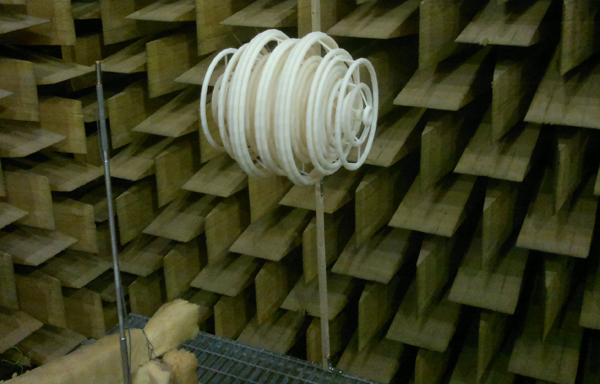It looks like you're using an Ad Blocker.
Please white-list or disable AboveTopSecret.com in your ad-blocking tool.
Thank you.
Some features of ATS will be disabled while you continue to use an ad-blocker.
3
share:
Concept could lead to sonar-defeating submarines or noise-cancelling highway barriers
A simple plastic shell has cloaked a three-dimensional object from sound waves for the first time. With some improvements, a similar cloak could eventually be used to reduce noise pollution and to allow ships and submarines to evade enemy detection. The experiments appear March 20 in Physical Review Letters.
Using computer algorithms, the researchers came up with a design made up of 60 rings of various sizes that form a cagelike structure around the sphere. Simulations indicated that sound waves scattering off the sphere and the ringed cloak would interfere with each other and cancel out. (Noise-cancelling headphones exploit this phenomenon by emitting sound waves that minimize ambient sounds in a room.)
Because the cloak did not need to steer sound waves in complicated ways, Sánchez-Dehesa and his team built it out of plastic with the help of a 3-D printer. They hung their creation from the ceiling of an echo-free chamber, pointed a speaker at it and played a range of sound frequencies. For most frequencies, the sphere scattered an easily detectable amount of sound. But at 8.55 kilohertz — an audible high pitch — the cloaked sphere became imperceptible to the sensors behind it.
The study marks the first time scientists have ever cloaked a three-dimensional object from sound. That’s probably music to the ears of the U.S. Office of Naval Research, which partially funded the study to explore the possibility of sonar invisibility.
However, this cloak is just a small step toward stealth submarines. It has to be custom designed and built for each object, and it works only for a narrow frequency range coming from one direction. If the speaker had been set up anywhere else, the cloak would not have worked. Sánchez-Dehesa’s team plans to develop broadband and multidirectional cloaks.
But Cummer points out that even a limited cloak can have useful applications. He suggests that structures capable of manipulating a specific sound frequency from one direction could help minimize noise pollution from a congested highway. “The cloak does one thing quite well, with a very simple structure,” he says.

www.sciencenews.org...
Wow this is amazing. I figured the first applications will be military as the article says. What is fascinating to me is how the design itself bounces the sound waves off itself to cancel out. The article states that most cloaks are dependent on exotic materials however this works of the architecture.
reply to post by Grimpachi
House walls or apartments could support these and reduce noise pollution. I could see all kinds of practical
applications!
House walls or apartments could support these and reduce noise pollution. I could see all kinds of practical
applications!
Originally posted by abeverage
reply to post by Grimpachi
House walls or apartments could support these and reduce noise pollution. I could see all kinds of practical
applications!
I don't think you understand. Inside that whole mess of 60 rings is a sphere that the 60 rings are preventing sound waves hitting that sphere.
Hanging these objects from your walls would only reduce noise pollution in the sphere. Not in your home.
could this be applied to help our sea life in any way?
i doubt it its only good for war (but i really hope not)
our sea life could do with a break
i doubt it its only good for war (but i really hope not)
our sea life could do with a break
reply to post by DaRAGE
However theoretically if you made a wall out of these it should stop all noise from passing through it.
However theoretically if you made a wall out of these it should stop all noise from passing through it.
Originally posted by DaRAGE
Originally posted by abeverage
reply to post by Grimpachi
House walls or apartments could support these and reduce noise pollution. I could see all kinds of practical
applications!
I don't think you understand. Inside that whole mess of 60 rings is a sphere that the 60 rings are preventing sound waves hitting that sphere.
Hanging these objects from your walls would only reduce noise pollution in the sphere. Not in your home.
Um...you miss the part of the practical application on highway walls? Or that the science will lead to creating sonar invisible subs? Where they gonna make the sub from those spheres? LOL geez don't be so superior.
The science behind it will open up new ways of isolating noise and will find different structures not just the sphere they created.
edit on
29-6-2013 by abeverage because: (no reason given)
new topics
-
Let's talk planes.
General Chit Chat: 7 hours ago -
January 6th report shows disturbing trend (nobody is shocked)
US Political Madness: 9 hours ago -
Inexplicable military simulation - virtual reality showdown in the night..
The Gray Area: 9 hours ago -
The Truth about Migrant Crime in Britain.
Social Issues and Civil Unrest: 10 hours ago
top topics
-
Trudeau Resigns! Breaking
Mainstream News: 12 hours ago, 26 flags -
January 6th report shows disturbing trend (nobody is shocked)
US Political Madness: 9 hours ago, 20 flags -
Live updates: Congress meets to certify Trump's presidential election victory
US Political Madness: 13 hours ago, 12 flags -
The Truth about Migrant Crime in Britain.
Social Issues and Civil Unrest: 10 hours ago, 10 flags -
Gravitic Propulsion--What IF the US and China Really Have it?
General Conspiracies: 14 hours ago, 9 flags -
Let's talk planes.
General Chit Chat: 7 hours ago, 5 flags -
Greatest thing you ever got, or bought?
General Chit Chat: 14 hours ago, 4 flags -
Inexplicable military simulation - virtual reality showdown in the night..
The Gray Area: 9 hours ago, 2 flags
3
